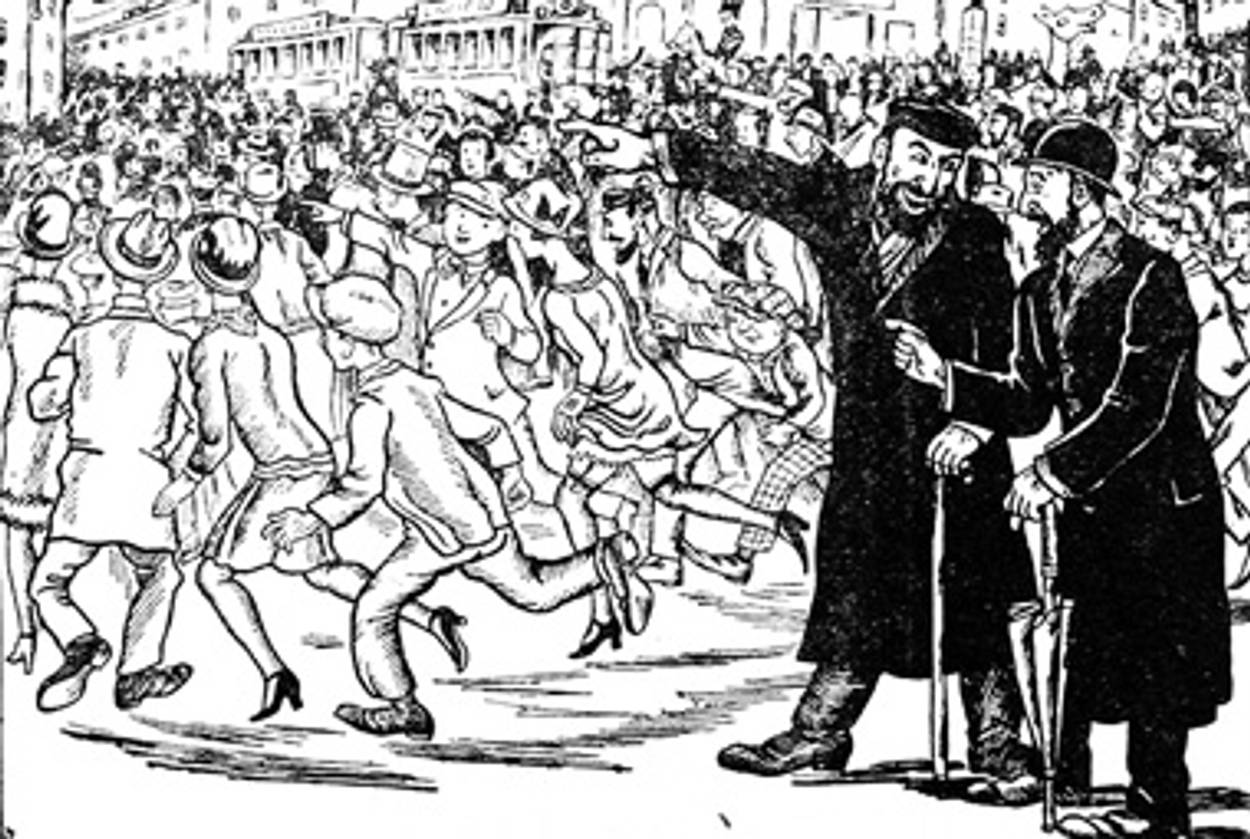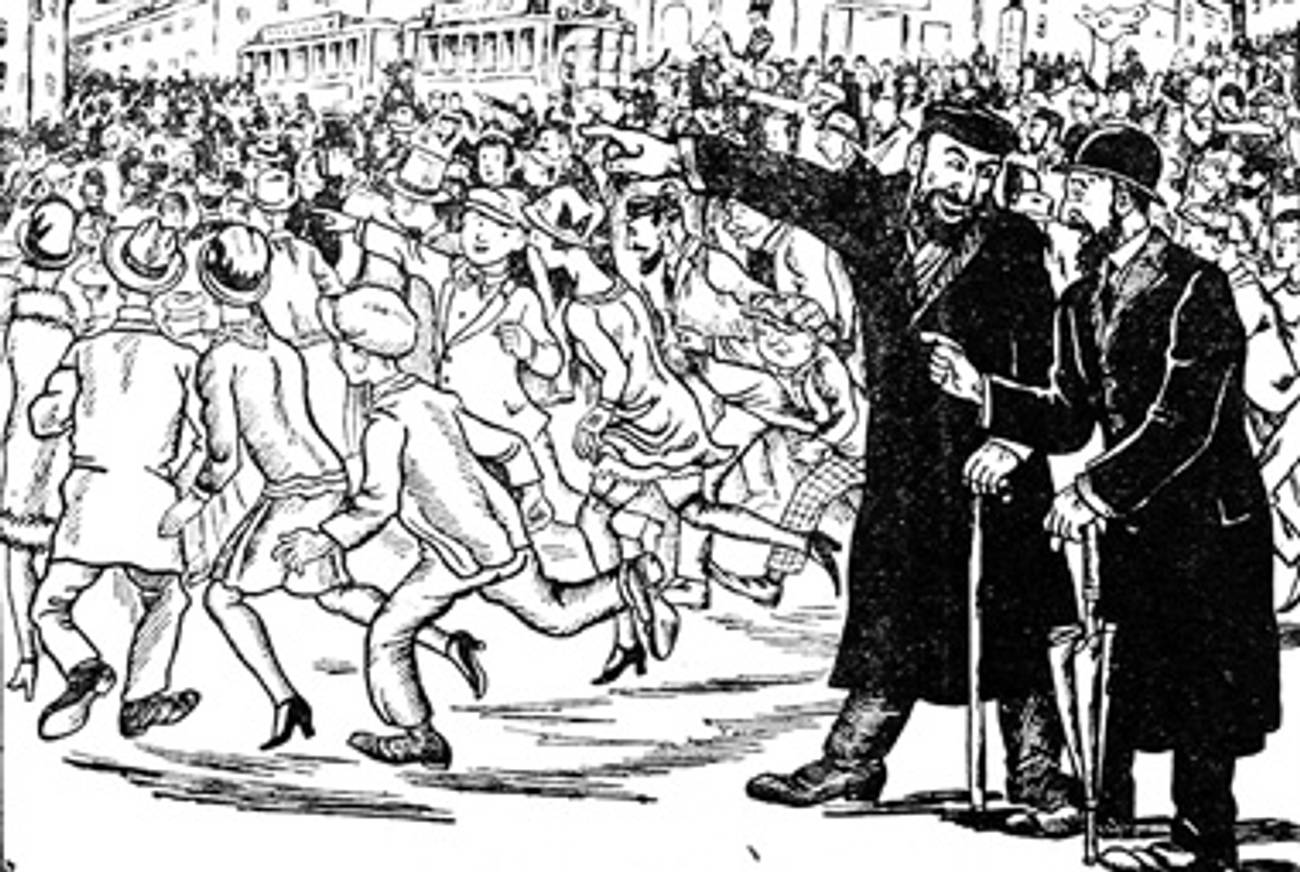Death Toll
Back when the Yiddish press relished covering suicides




One of the convenient aspects of studying Jewish history is its 3,000-year-old paper trail—the texts and records of the rabbinical and intellectual elite allow us to examine contours of Jewish law and history. But in contrast, we tend to know less about the lives of average Jews, whose lives didn’t receive much attention in the writings of the intellectuals. That began to change in the late 19th century, when the Yiddish press hit the streets, for the first time recounting the lives of the unwashed masses of Jews in the public record. Tablet Magazine offers some of their stories, reconstructed from century-old newspaper accounts.
Although suicide is categorized as a type of murder in the Jewish tradition, its illicit nature has not stopped everyone from shuffling off their mortal coils on their own terms. Statistics indicate that though Jews are less apt than other groups to commit suicide, they are not removed from it altogether. And at certain times and in certain places, suicide has actually increased among Jews, especially when economic and social conditions have gone south. One 19th-century German statistic indicates that as rates of assimilation grew among Jews, so did rates of suicide. There’s nothing like a conflicted identity to make one feel like ending it all.
Because of suicide’s disreputable status in Jewish law and because, as is so often the case, it was frequently a mystery why a close friend or relative threw himself off the top of a building or drank a vial of poison, suicides were a source of embarrassment to survivors. The departed became the topic of family secrets. Once the Yiddish press came along, though, it was tough to keep anything in Jewish life very private.
In Warsaw, for example, there were huge numbers of suicides during the 1920s and 1930s, which reporters wrote about with gusto at least once, and often multiple times, each day. Readers seemed to love nothing more than a juicy story with an unhappy ending.
“The number of suicides has increased in a frightening manner on the Jewish street. Not a day goes by without at least a couple of Jewish suicides,” began an August 1931 article in Moment. The story tells of three suicides that occurred the previous day: 19-year-old Benjamin Levin killed himself by asphyxiation; 26-year-old Yitzhok (no last name given) poisoned himself with iodine; and 38-year-old Dvoyre Berger jumped out of a fourth-story window. The latter two deaths were understood to have been undertaken as a result of severe poverty, the reason for many Warsaw Jewish suicides, especially during the Depression.
Reporters who worked the suicide beat were usually anonymous, although journalists of note, including Dr. Gershon Levin and Shaul-Yitzhok Stupnitski, wrote articles every few years decrying the plague of suicides that had descended on the community and asking what could be done to stop them. Levin, for one, argued that the large number of Jewish suicides was the result of alienation from traditional life, the laws of which acted as a cork, plugging potentially explosive personalities.
No population in the Jewish community was immune to suicides; every group from the secular to the Hasidic experienced them. According to Haynt, in February, 1931, in the Polish shtetl of Lusiev, Shevakh Halperin jumped into a well wearing his tallis and tefillin; in August of the same year, Anshel Gotfried ended up as a floater after drinking poison in Lemberg’s biggest mikveh.
Many of the victims had tried killing themselves more than once. “For the third time, the nervous tallis dealer Avrom Aba Lehrer tried to commit suicide,” reported Warsaw’s Haynt in September 1927. “A few months ago, on a beautiful summer’s night by the light of a full moon, he attempted to hang himself by a beam under a wooden bridge on the Vistula near the Citadel. But the rope was too weak and it broke. Lehrer fell between the pillars of the bridge and lay there all night with the noose still around his neck.” Botched suicide attempts spun off into the creation of “suicide comedy” in the pages of the city’s Yiddish humor mags.
Pinye Rogochinsky, a Warsaw Socialist who lived with his three brothers, was known as the “Shabbos Suicide,” for his failed attempts to kill himself on the Sabbath. One day, reported Moment in March, 1927, after having caught a cold, he stayed home in the rented room the brothers shared on Stavski Street. At about 11 that morning, neighbors heard screams. They tried to open the apartment door to no avail; it was locked. They could hear Pinye thrashing about as his wails grew louder. When they finally broke the door down, the neighbors found him with a knife in his hand, lying in a pool of blood. Having nearly butchered himself, Pinye howled to his neighbors, “Down with the bourgeoisie!”
Among those who attempted to confront the suicide crisis was Reuben Gildenstern. Having grown up in early-20th-century Palestine, he traveled to Europe after receiving a large inheritance. While abroad, Gildenstern, who spent two years on the Russian estate of Leo Tolstoy as a literary groupie, fell in love. His affections were unrequited, and he ended up attempting suicide a total of eight times. In a 1926 interview in Moment, he said he had no regrets about “remaining among the living” and dedicated his life to helping those with similar temptations resist them. Gildenstern created a club in Vienna where survivors of attempted suicide could enjoy one another’s company. He also wanted to launch a Budapest-based magazine titled Der Selbstmörder or The Suicide. His plan was to hire only what he called “one-time suicide candidates” as his writers, editors, typesetters, and printers. These people were, he felt, the best candidates to understand what it meant to feel the need to kill oneself. He was adamant on this point, which is perhaps why the magazine never came to fruition.
But the ever-resourceful reporters of Warsaw’s Yiddish press could always be counted on to bring in a good suicide story. And, during the 1920s and 1930s, at least a handful appeared each day in the crime blotter. Suicide was a type of murder, after all, and as such required investigation. Whether it was the story of the woman who was sliced in half after capriciously diving under the wheels of a tramway car while on an afternoon stroll with her father-in-law, or the high-school student who hanged himself in detention, or the spurned lover who drank poison and leaped out of a fourth-story window into the courtyard of his ex-girlfriend’s building, these minor, daily tragedies kept the readers of Warsaw’s Yiddish press horribly entertained.
***
Here are some samples of Yiddish press accounts of suicides.
Moment, April 1927
“The Anatomical Institute Returns the Body of a Jewish Suicide Because the Bones Are Worthless”
As readers remember from December of last year, a young Jewish girl committed suicide by jumping from the fourth floor (on Targova St.) because she was not able to recover from tuberculosis.
That victim, Rokhl Weinstein, left a will saying that her body should be donated to the Anatomical Institute so “it can be helpful in finding a cure for this dreadful disease” of which she was a victim. That exact expression was taken directly from her will, which she had scrawled in ink on her body. Not wanting to deny her wish, the dead girl’s family did not try to oppose her decision and the body was sent to the Anatomical Institute, where it has been for the last four months.
On Saturday, the Burial Society received a notice from the Anatomical Institute, saying that the body of Rokhl Weinstein is of no value for scientific inquiry, because the most important bones were damaged by the tuberculosis. Therefore, they do not need the body and request that they take it.
Yesterday, the Burial Society picked up the body and the burial takes place today.
And so ends the tragic life story of 17 year-old Rokhl Weinstein. Even her bones are worthless. Even the humanitarian efforts she attempted in her could not be fulfilled.
Moment, May 1927
“Jewish Boy Commits Suicide in the Courtyard of his Ex-Fiancee on 19 Mila St.”
Around 9 am, a number of residents of 19 Mila Street watched as a young man leapt out of a third story window.
The victim landed on the thick electrical wires that spanned the courtyard on the second floor level and he remained there, dangling.
Many people came running to see what happened after hearing screams. In the midst of the chaos, no one could figure out what to do.
In the meantime, after hanging on the wires for a number of minutes, the victim fell onto the brick street, receiving horrible bruises over his entire body.
Emergency services were called and the doctor who arrived determined that the victim drank a large dose of iodine before jumping.
The victim was brought to the Jewish hospital on Tshista Street in critical condition. It appears that the victim was 18 year-old Yekhiel Braf, who had only a mother in the town of Kotsk. He came alone to Warsaw a few years ago and lived with his cousin, Khaym-Dovid Braf on 20 Mila Street.
The young man had studied to become a tailor and earned a decent wage. Recently, he began going to dance halls with his friends, where he showed off his skill as an excellent dancer.
Not long ago, Yekhiel made the acquaintance of Ms. Brontshe P. (19 Mila St.), also known as Brontshe the Cossack. She was also an excellent dancer and Yekhiel quickly fell in love with her.
Because Brontshe liked going out with elegant gentlemen and partying, the boy spent his entire savings on dates and theater tickets.
During Passover, Yekhiel went to visit his mother in Kotsk. He went to tell her that he had found his basherte and that he was preparing to get married.
During this time, however, Brontshe met another young man who was better off financially than Yekhiel. When Yekhiel got back to Warsaw, Brontshe made it clear that she didn’t want anything to do with him.
Yekhiel took it real hard. He stopped working and would walk around for days at a time as if there were a black cloud over him.
Yesterday at about 6 am he went over to Bzovski’s Pharmacy on Mila Street and bought a bottle of iodine. He went home with the bottle of poison with the intention of taking it in bed. But after getting in bed, his plans suddenly changed: he decided to go kill himself in the same house where his unfaithful “bride” lived.
At about 8:30 am he left home for 19 Mila Street. He wandered around the front gate for a while because he thought Brontshe might pass by and he would get to see her one last time.
Finally, he went up the stairs, drank the bottle of iodine and jumped out of the window.
When Brontshe found out about it, she also wanted to poison herself. But residents saw what was happening and they stopped her. The condition of the victim is critical, but not hopeless.
Eddy Portnoy, a contributing editor for Tablet Magazine, is the Academic Advisor and Exhibitions Curator at the YIVO Institute for Jewish Research. He is also the author of Bad Rabbi and Other Strange but True Stories from the Yiddish Press.
Eddy Portnoy is academic adviser and director of exhibitions at the YIVO Institute for Jewish Research, as well as the author of Bad Rabbi and Other Strange but True Stories from the Yiddish Press (Stanford University Press 2017).